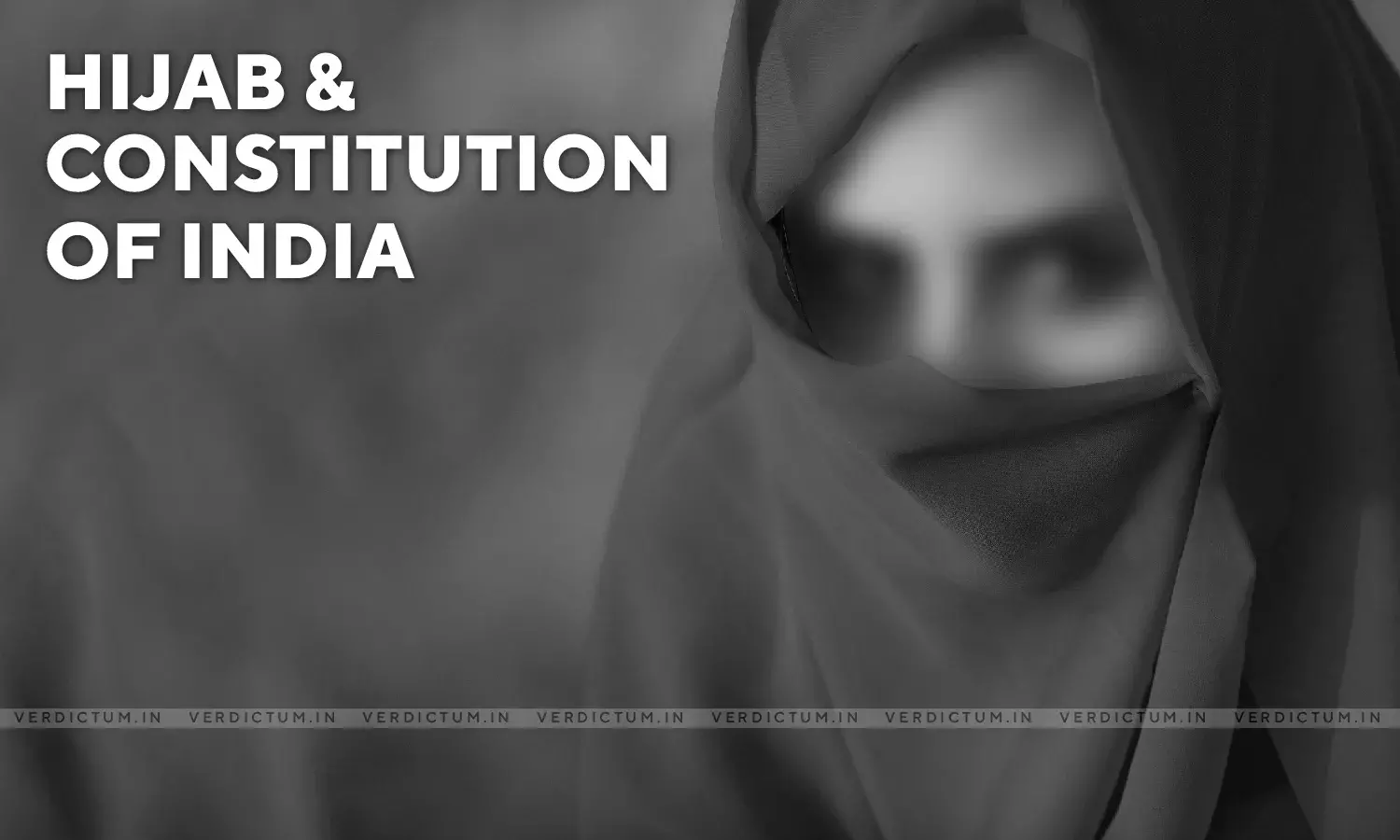Examining The Hijab-In-Classroom Debate From A Constitutional Perspective
Earlier this year, some female Muslim students at a Pre-University College (PUC) in Udupi attempted to enter their class while wearing a Hijab. The headmaster forbade the girls from attending classes because they were dressed in Islamic robes. He pointed out that it rendered the concept of uniform superfluous.
Subsequently, by way of the Government Order dated 5th February 2022 issued under Sections 7 & 133 of the Karnataka Education Act, 1983, a direction was issued upon the College Development Committees all over the State to prescribe 'Student Uniform', in terms of Rule 11 of Karnataka Educational Institutions (Classification, Regulation & Prescription of Curricula, etc.) Rules, 1995.
Several writ petitions have been filed before the Karnataka High Court challenging the insistence of certain educational institutions that no girl student shall wear the hijab whilst in classrooms and also challenging the aforementioned Government Order.
This has once again sparked the hotly debated issues of right to freedom of religion and secularism in India.
Where does the insistence upon wearing a Hijab in a classroom stand in the context of India being a "secular" republic?
The Preamble to the Constitution of India solemnly declares that India is a "Sovereign Socialist Secular Democratic Republic".
Secularism is one of the foundational principles of the Indian Constitution and one of the bedrock of our polity and way of life. However, because of the absence of a fixed definition in the Constitution of what it means to be a "secular" republic, secularism in the Indian context has always been subjected to a myriad of ideas and opinions.
Does secularism mean a strict separation of religion and state or does it mean treatment of all religions equally by the state? Does secularism permit regulation or restriction of a religious action by a state and to what end?
Is permitting Muslim female students to wear a Hijab in the classroom secular and permissible or is banning the wearing of the Hijab whilst in a classroom secular and permissible?
One may look to the following view of secularism in the Indian context, propounded by the Supreme Court of India, as a guidepost for this discussion:
"62. That India is a secular State is no longer res integra. Secularism has been declared by this Court to be one of the basic features of the Constitution. A long line of decisions delivered by this Court on the subject have explained the meaning of the terms "secular" and "secularism", but before we refer to the judicial pronouncements on the subject we may gainfully refer to what Dr Radhakrishnan, the noted statesman/philosopher had to say about India being a secular State in the following passage:
"When India is said to be a secular State, it does not mean that we reject reality of an unseen spirit or the relevance of religion to life or that we exalt irreligion. It does not mean that secularism itself becomes a positive religion or that the State assumes divine prerogatives. Though faith in the Supreme is the basic principle of the Indian tradition, the Indian State will not identify itself with or be controlled by any particular religion. We hold that no one religion should be given preferential status, or unique distinction, that no one religion should be accorded special privileges in national life or international relations for that would be a violation of the basic principles of democracy and contrary to the best interests of religion and Government. This view of religious impartiality, of comprehension and forbearance, has a prophetic role to play within the national and international life. No group of citizens shall arrogate to itself rights and privileges, which it denies to others. No person should suffer any form of disability or discrimination because of his religion but all like should be free to share to the fullest degree in the common life. This is the basic principle involved in the separation of church and State."
Thus, secularism in the Indian context means that the Indian State will not identify itself with or be controlled by any particular religion. At the same time, it shall not permit any one religion or religious group to assume or enjoy a preferential status or privileges. It follows from this that allowing Muslim girl students to wear the Hijab in a classroom would have the effect of conferring upon them a preferential concession which would be asecular.
The other question is, would there be an unfettered right to wear a hijab in a classroom under the right to freedom of religion?
To freely profess, practise and propagate religion of one's choice is a fundamental right guaranteed under Article 25 of the Indian Constitution. That is subject only to the following— (1) public order, (2) health, (3) morality and (4) other provisions of Part III dealing with fundamental rights. Under Article 25(2) of the Constitution of India, the State is also granted power to make law in two contingencies notwithstanding the freedom granted under Article 25(1). Article 25(2) states that:
"25. (2) Nothing in this article shall affect the operation of any existing law or prevent the State from making any law—
(a) regulating or restricting any economic, financial, political or other secular activity which may be associated with religious practice;
(b) providing for social welfare and reform or the throwing open of Hindu religious institutions of a public character to all classes and sections of Hindus."
Thus, the right under Article 25 to freely practice one's religion is subject to, inter alia, "public order", "health", "morality" and other provisions of Part III dealing with fundamental rights. Furthermore, the State, under Article 25(2)(a), can make a law regulating or restricting any "secular activity" which may be associated with a religious practice.
The State has issued the restriction on wearing hijab in a classroom purportedly on the rationale that allowing overt display of religious symbolism through clothing would "lead to a student acquiring a distinct identity" which would be "not conducive to academic environment". The state has also defended its decision as a means to "protect public order".
Wearing a hijab as a facet of right to freely practice one's religion, is also subject to "morality", which has been interpreted by the Supreme Court of India to mean "constitutional morality".
Constitutional morality has been understood to mean a view of morality which is supported by the Constitutional principles.
If secularism as mentioned in the Preamble of our Constitution is a part of the basic structure of our Constitution as has been held by the Hon'ble Supreme Court in Bommai, it would naturally follow that secularism being a core Constitutional principle is a part of "constitutional morality" and the purported right to wear a hijab to practice one's religion would be subject to the State making restrictions in the interest of upholding constitutional morality or the secular ethos.
Further, under Article 25(2)(a), the State can make a law regulating or restricting any "secular activity" which may be associated with a religious practice. It has been widely held that a secular practice is one which is not an essential or an integral part of a religion.
This has been tritely explained in Durgah Committee v. Syed Hussain Ali, AIR 1961 SC 1402:
"33. … that in order that the practices in question should be treated as a part of religion they must be regarded by the said religion as its essential and integral part; otherwise even purely secular practices which are not an essential or an integral part of religion are apt to be clothed with a religious form and may make a claim for being treated as religious practices within the meaning of Article 26. Similarly, even practices though religious may have sprung from merely superstitious beliefs and may in that sense be extraneous and unessential accretions to religion itself. Unless such practices are found to constitute an essential and integral part of a religion their claim for the protection under Article 26 may have to be carefully scrutinised; in other words, the protection must be confined to such religious practices as are an essential and an integral part of it and no other."
This brings us to the all-important question- What is a Hijab and does the Quran mandatorily prescribe the Hijab for women?
A hijab is a religious veil worn by certain Muslim women in public, which covers the head and chest, and sometimes the face.
There are several authorities which emphasize that the Quran does not prescribe the Hijab as a compulsory article of clothing for a Muslim woman.
The word hijab does not occur in Qur'an for veiling the face of an ordinary Muslim woman. It was only meant for the wives of the Prophet; the Bedouin Arabs would talk freely with the Prophet's wives after dinner, not being acquainted with the pertinent cultural norms. The Prophet did not like it and hence it was revealed that men should leave after dinner; if they talk with the wives of the Prophet, they should talk from behind the curtain, hijab. For other women, the word hijab or burqa does not occur in the Qur'an at all.
In Ajmal Khan vs. The Election Commission of India (2006 SCC OnLine Mad 794), it has been held by the Madras High Court that:
"13. The Canadian writers Syed Mumtaz Ali and Rabia Mills in their essay Social Degradation of Women - a Crime and a Libel on Islam explain:
"One must realize and appreciate the fact that the commandment in the Qur'an in Chapter 33, Verse 53, with respect to the Hijab, applies only to the "Mothers of the believers" (the wives of the Holy Prophet, p.b.u.h.) whereas the wording of the Qur'an in Chapter 33 Verse 55, applies to all Muslim women in general. No screen or Hijab (Purdah) is mentioned in this verse − it prescribes only a veil to cover the bosom and modesty in dress. Hence the unlawfulness of the practice of the Indian-style system of Purdah (full face veiling). Under this system, the Hijab is not only imposed upon all Muslim women, but it is also quite often forced upon them in an obligatory and mandatory fashion. Even the literal reading/translation of this Quranic verse does not support the assertion that the Hijab is recommended for all Muslim women. The Hijab/screen was a special feature of honour for the Prophet's p.b.u.h. wives and it was introduced only about five or six years before his death."
14. In the English translation of Koran by Muhammad Asad in Note 37 states "We may safely assume that the meaning of illa ma zahara minha is much wider, and that the deliberate vagueness of this phrase is meant to allow for all the time-bound changes that are necessary for man's moral and social growth." In the Article "The Question of Hijab: Suppression or Liberation" published by The Institute of Islamic Information and Education (III & E) and reproduced in electronic form by Islamic Academy for Scientific Research the author states that the question of Hijab (Purdah) for Muslim women has been a controversy for centuries and will probably continue for many more. Some learned people do not consider the subject open to discussion and consider that covering the face is required, while a majority are of the opinion that it is not required. A middle line position is taken by some who claim that the instructions are vague and open to individual discretion depending on the situation. The wives of the Prophet(s) were required to cover their faces so that men would not think of them in sexual terms since they were the "Mothers of the Believers" but this requirement was not extended to other women."
Thus, it has been authoritatively held that wearing of the Hijab is neither recommended nor mandated for all Muslim women. In other words, wearing of the Hijab is not an essential religious practice in Islam.
This has been reiterated by the Bombay High Court in Fathema Hussain Sayed v. Bharat Education Society, 2002 SCC OnLine Bom 713, where it was held that:
"5. ….. we find it difficult to accept the submission of the learned counsel that by not permitting the petitioner to wear head-scarf, the fundamental right of the petitioner under Article 25 is violated. …
6. By asking petitioner who is student in class VIth standard of respondent No. 2 school to maintain the dress code prescribed by the school, how can it be said that the petitioner's fundamental right of freedom of conscience and free profession, practice and propagation of religion is violated. Article 25 guarantees that every person in India shall have freedom of conscience and shall have the right to profess, practice and propagate religion, subject to restrictions imposed by the State on the grounds of; (i) public order, morality and health; (ii) other provisions of the Constitution; (iii) regulation of non-religious activity associated with religious practice; (iv) social welfare and reform etc. There does not seem to be such established practice and profession of the Islam religion from covering their heads by the girls studying in all girls school. …
7. …. The essence of Muslim religion or Islam cannot be said to have been interfered with by directing petitioner not to wear head-scarf in the school.
Thus, the insistence by the State that no girl student shall wear the hijab whilst in classrooms is not violative of the Right under Article 25 in as much as wearing of a hijab is not an essential practice of the Islamic religion.
Interestingly, a Turkish law banning the wearing of hijab at universities and other educational and state institutions was upheld by the European Court of Human Rights in Leyla Sahin vs. Turkey. It held that it was important to observe religious and denominational impartiality in public schools as the education was compulsory and children from many religions studied there. The ECtHR also held that the restriction of religious freedoms in the form of religious attire was proportionate to the aim of promoting democracy through the maintenance of secularism.
Allowing wearing of hijab in the classrooms would also amount to elevating Islam over other religions and is contrary to the secular character of a classroom and the equality principle. Wearing of a school uniform is an expression of equality. Permitting the Muslim students to wear the hijab entails treating them differently from the rest of the students and entails a departure or exemption from the school uniform rules and violates the equality and neutrality principle which is enshrined in the concept of a school uniform.
Thus, the prescription that no girl student shall wear the hijab whilst in classrooms passes Constitutional muster and one is optimistic that the Hon'ble Court would uphold the right of the State to ensure that our classrooms remain equal and secular spaces where the true meaning of our Constitutional values can be shaped, developed and imparted.
Shruti Agarwal is an Advocate-on-Record in the Supreme Court of India and a Chevening Scholar.
[The opinions expressed in this article are those of the author. Verdictum does not assume any responsibility or liability for the contents of the article.]












